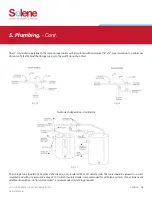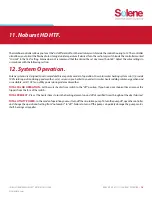
With both charge faucets now open, run the Flojet pressure pump until the pinkish glycol mixture begins flowing into the empty
bucket. Quickly switch the hose from the empty/return bucket to the bucket containing the glycol mixture. Continue to circulate
the fluid using the pressure pump until the bubbling has stopped and the air has been purged.
After charging the collector loop, shut the lower charge faucet and let the pressure pump drive up the loop pressure to the
appropriate level (Generally in the range of 25 psi). To more accurately calculate the proper pressure measure the height of the
solar collector above the solar storage tank and divide this number by 2.31. Then add 20 psi to this number. As a word of caution,
the pressure in the glycol loop should not exceed 45 psi when the system is operational on a good sunny day.
After you have determined the integrity of the entire piping system turn on the circulating pump. Do this by setting the manual
switch within the controller to the “on” position. Run the pump for a full five minutes and carefully check to ensure there is
proper fluid flow and that all the air has been purged from the solar collector glycol loop. An inexpensive flow meter such as
manufactured by Blue White Industries or Letro is recommended as an optional system component. A flow meter allows you to
monitor and adjust the flow rate through the piping and also to visually inspect the HTF fluid quality.
Set the controller to the “off” position and proceed to the next step.
Mix the propylene glycol and distilled water mixture in accordance with Table 4 and Table 5 in a large clean bucket. You will need
a second empty bucket as well. The charging process also will require a low flow diaphragm pump (Flojet or equal) to fill and
pressurize the collector loop.
Connect the discharge side of the pressure pump to the upper charge faucet. Place the pump suction side hose in the glycol
solution. Close the isolation ball valve and connect a second hose to the lower charge faucet. Place the other end of the hose in
the empty bucket. Open the upper charge faucet and allow the pressure from the expansion tank to push the water in the glycol
loop back to prime the pressure pump. When the hose in the bucket containing the glycol mixture stops bubbling you may begin
charging the collector loop with glycol.
8.
9.
4.
5.
6.
7.
CHARGING THE SYSTEM.
-
13
10. Charging the System.
- Cont.
INSTALLATION MANUAL SOLENE
®
HOT WATER SYSTEMS
©
2014 UMA Solar
SYSTEM PROTECTION -
Freeze is the temperature where the first ice crystal forms in the fluid. Flow is the temperature where the
fluid will contain ice crystals but still flow. Burst is the temperature where the fluid is solid, expanding and bursting the vessel.
*THE AO SMITH SUNX 80 OR SUNX 120 HEAT EXCHANGER HAS A 2.8 OR 4 GALLON FLUID CAPACITY. THIS TABLE ASSUMES A TOTAL
100 foot PIPE RUN USING ¾” TYPE M HARD COPPER TUBING.
CONTACT YOUR SOLAR CONTRACTOR IF THE CHARGED COLLECTOR LOOP PRESSURE EXCEEDS THIS THRESHOLD.
100%
-60°F
-70°F
-100°F
75%
-60°F
-60°F
-100°F
50%
-30°F
-40°F
-75°F
40%
-7°F
-15°F
-60°F
35%
0°F
-10°F
-60°F
Noburst HD
Freeze Point
Flow Point
Burst Point
















































